Why gooseberry leaves fall and how to deal with it
Falling leaves are a sign that the gooseberry has health problems. In this way, the plant signals a lack of nutrition or diseases, pests, or damage to the root system. Sometimes leaf shedding occurs for one reason, sometimes there are several. If measures are not taken, the plant will die and it will be impossible to restore it. Let's look at why gooseberries shed leaves in summer and what to do.
Causes of gooseberry leaves falling and what to do about it
This problem occurs in both mature and young shrubs. Let's figure out why gooseberry leaves fall in June or July. There are several reasons for this: improper care, inappropriate planting location, diseases or pests.
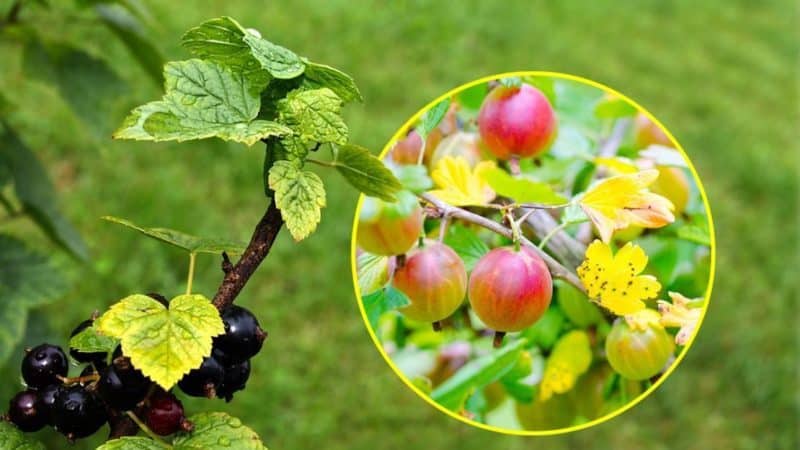
Watering and mulching the soil
The gooseberry root system lies close to the soil surface, so water gets to it without problems. Water the plant moderately and often. It is not allowed to “flood” the bush once a month, thinking that such a supply of water will last for a long time.
With a lack of moisture, gooseberries prematurely shed their leaves at any time during the growing season: during flowering, fruiting, and after harvesting. A lack of water is especially dangerous during the period of berry growth - in addition to the bare bush, summer residents can expect small and insipid fruits.
Experienced gardeners recommend paying special attention to watering during dry and dry summers. This is true for southern regions and areas where it rarely rains. For convenience, summer residents use a drip irrigation system.Gooseberries have a weak root system, so the water is heated in the sun. The optimal time to moisturize is evening. Sprinkling can also be used, but it causes development diseases and pests.
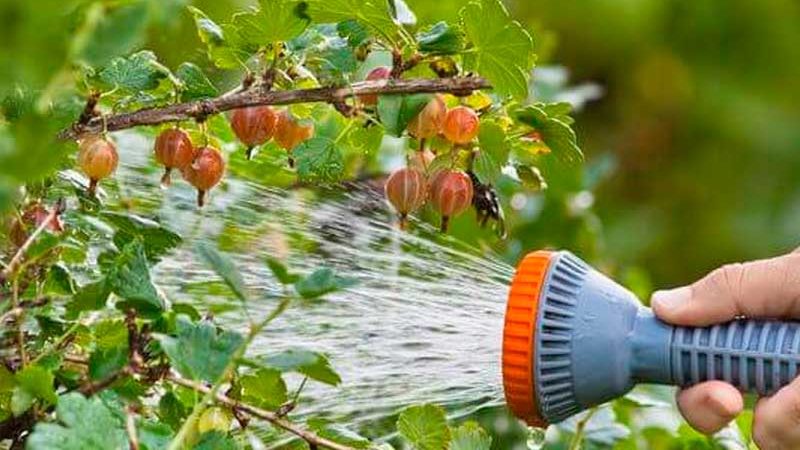
Preparing the plant for winter
Preparing the plant for winter includes cleaning the berry garden, removing and burning plant residues and debris, sanitary or formative pruning and shelter.
The procedures begin after harveststarting from July and ending in September. It is important to carry out the activities sequentially so as not to damage the bush. Otherwise, the plant will weaken, which will cause the leaves to fall off.
Procedures:
- Garbage, weeds and fallen leaves are burned outside the garden area. The first harvesting is carried out immediately after harvesting, the second - when the leaves fall. You cannot add fallen leaves to mulch or compost heap: this leads to the development of diseases.
- After harvesting, they dig up the soil so that the pests hidden in it appear on the surface and die. The digging depth near the bush should not exceed 6 cm, so as not to damage the fragile root system.
- Pruning is carried out at the end of August or beginning of September: diseased, old and dry shoots, as well as shoots, broken and tangled branches are removed with garden pruners. Next, shoots lying on the ground and those that are more than 5 years old are cut off. The purpose of pruning is to form a healthy bush with a large number of fruit-bearing branches. The procedure is carried out annually to avoid dense plantings, diseases and pests.
- Cover gooseberries 2-3 weeks before frost. The shoots are pressed to the ground and fixed with planks. The base of the bush is mulched, the plant is covered with agrospan, film, agrofibre.This is especially true for regions with cold winters. If there is no covering material, the gooseberries are covered with snow when it falls.
Top dressing
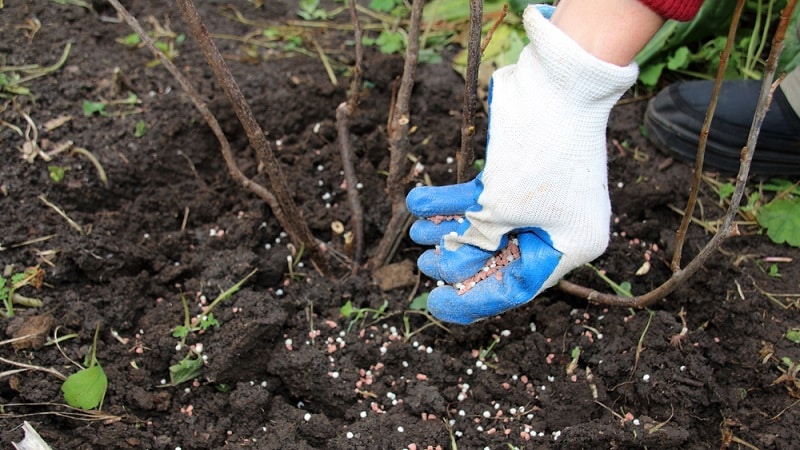
If all the leaves have fallen, the reason may lie in the lack of phosphorus-potassium fertilizers. The plant needs them all year round, especially after harvest. The funds are applied at the end of July or August, after removing the weeds and loosening the soil. This way the gooseberry will better absorb microelements. For feeding, potassium monophosphate, potassium sulfate, and double superphosphate are used. If the plant is more than 5 years old, 100 g of dry wood ash is added to it.
Attention! To compensate for the lack of phosphorus-potassium fertilizers, gardeners use ready-made universal fertilizer “Good Power” for vegetable, fruit and berry crops. In addition to phosphorus and potassium, it contains humic acids, boron, iron, zinc, magnesium, and succinic acid. 10 ml of fertilizer is diluted in 10 liters of water and applied under the bush. Ready-made fertilizers “Krepysh” or “Zdraven” are also used.
Experienced gardeners also pay attention to foliar feeding. After harvesting, gooseberries are sprayed with Topsin-M solution. A systemic fungicide that controls the causes of leaf drop, including diseases and pests. Some summer residents use a solution of iron sulfate. To prepare, you need a bucket of water and 300 g of the substance. Gooseberries are sprayed after leaf fall.
Diseases and their treatment
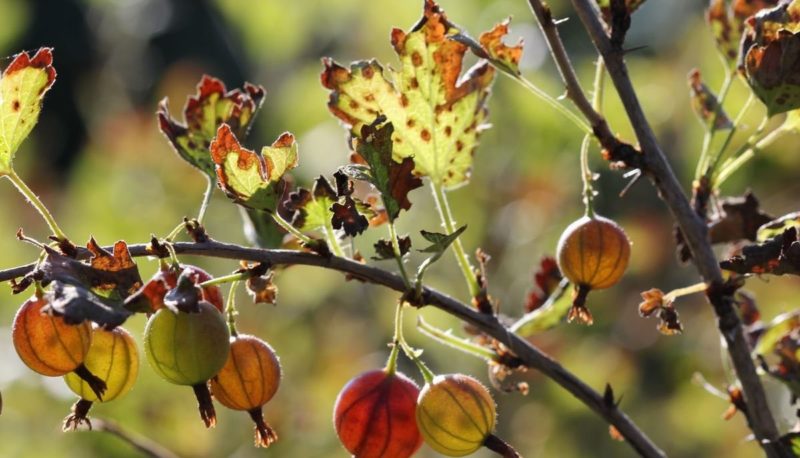
Leaves also fall due to fungal, viral or bacterial diseases. They arise for various reasons: an excess of microelements, contaminated soil, weeds and debris, waterlogging, hot weather. The sooner a summer resident detects signs and symptoms of the disease, the sooner treatment will begin.Frequent problems with gooseberries are American powdery mildew, goblet rust and septoria.
For American powdery mildew shoots, leaves and fruits are covered with a white coating. After a week, the shoots become bent, the berries become deformed, the leaves curl and dry out, and then fall off. Often the disease appears due to debris and weeds that grow under the berry garden. Fungal spores are frost-resistant, so it is recommended to treat the soil several times a year. The disease is treated with the fungicide "Tiovit Jet".
Due to glass rust reddish-brown small spots appear on the leaf blades spots, which over time swell and become like furry footprints. Fungal spores are carried by wind or rain and quickly infect nearby growing crops. They treat goblet rust with Oxychom, Topaz, and Propi Plus. Fungicides are easy to use and are sold at any gardening store.
Another reason for leaf fall in summer is a non-infectious disease - marginal necrosis.. The reason is potassium deficiency, which causes the tips of the leaves to dry out, become covered with a gray coating and fall off. For treatment, gooseberries are sprayed with a solution of potassium sulfate (a bucket of water + 50 g of the substance). Spray the bushes in the evening, using personal protective equipment: gloves, a respirator and goggles.
Pests and their control
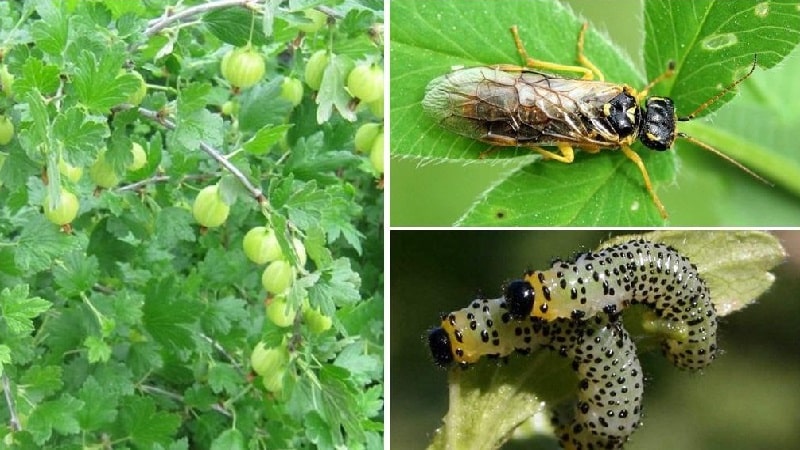
Insect pests are common in berry gardens where weeds are not removed and the soil is not dug or loosened. They appear in spring, summer and even late autumn. A frequent visitor to gooseberries is the spider mite. The little green insect especially loves young plants.
The pest sucks out the juice, resulting in leaves begin to turn yellow and dry out. When spider mites appear, use an infusion of tobacco: 2 tbsp per 5 liters of water. tobacco dust. Water and dust are mixed and left for 3 days. The solution is filtered and poured into a spray bottle.
If caterpillars, aphids or whiteflies appear on gooseberries, use the drug “Fufanon”. It affects pests immediately after processing, harmless to humans. Kinmiks is also used against pests. It is sold in ampoules, is easy to prepare, and instantly acts against larvae and adults.
Prevention of diseases and pests - what to do to prevent leaves from falling off
To prevent premature falling of leaves, summer residents pay attention to spring, summer and autumn preventive measures.
The procedures protect gooseberries from diseases and pests, strengthen the immune system, and normalize metabolic processes:
- annual garbage collection and leaf burning;
- regular weeding;
- spraying gooseberries with ash, tobacco, nettle solution;
- pruning and thinning of bushes;
- autumn digging of the soil;
- application of potassium-phosphorus fertilizers;
- shelter for the winter;
- regular inspection of bushes for the presence diseases and insects.
Conclusion
What to do if the gooseberry has dropped its leaves? First of all, find out the reason. There may be several of them: lack of microelements, errors in care, improper watering or fertilizing. Leaves often fall off due to diseases: American powdery mildew, goblet rust, marginal necrosis.
To avoid problems, they carry out preventive measures: remove weeds and burn fallen leaves, spray the gooseberries with protective agents, and cover them for the winter.